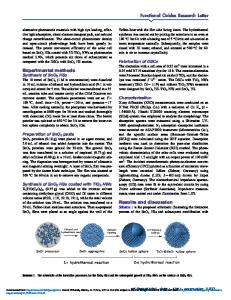Synthesis of mesoscopic hollow spheres and inner surface functionalized hollow spheres of titanium dioxide by the liquid
- PDF / 225,256 Bytes
- 5 Pages / 612 x 792 pts (letter) Page_size
- 1 Downloads / 309 Views
Shigehito Deki Department of Chemical Science and Engineering, Faculty of Engineering, Kobe University, Rokkodai-cho, Nada, Kobe 657-8501, Japan (Received 21 March 2003; accepted 15 September 2003)
Polystyrene (PS) core–TiO2 shell composite particles and TiO2 hollow spheres were fabricated using the liquid phase deposition (LPD) method. Composite particles were prepared using PS particles as templates. Calcination of the composite particles resulted in TiO2 hollow spheres. Uniform TiO2 hollow spheres were obtained when the reaction time of the LPD process was between 4 and 8 h. Furthermore, we fabricated TiO2 hollow spheres whose inner surfaces were functionalized by Pt particles after platinized PS particles were used as templates. The Pt particles were immobilized on the inner surfaces of the hollow spheres.
I. INTRODUCTION
Recently, there has been much interest in the fabrication of ceramic hollow spheres that have micro- and nanometer dimensions because such particles exhibit interesting properties.1–3 These particles have great potential in the fields of electronics, photonics, optics, magnetics, and so on. They can also serve as catalysts and small containers for encapsulation in small reactors and drug delivery systems. A number of experimental efforts have been made to fabricate ceramic hollow spheres. The process generally includes the controlled deposition of desired materials by using precipitation reactions with sol-gel techniques3,4 or layer-by-layer self-assembly techniques,1,2,5–8 on colloidal polymer particles that serve as templates; the template is subsequently removed by calcination. Recently, we have developed a unique process of depositing metal oxide thin films from aqueous solution called the liquid phase deposition (LPD) method.9–13 Various kinds of metal oxides and multi-component metal oxides can be deposited on a variety of substrates by LPD.9–13 The LPD method utilizes a chemical equilibrium reaction between metal-fluoro complex species (MFx(x−2n)−) and metal oxides in an aqueous solution. Since this method is performed in an aqueous
a)
Address all correspondence to this author. e-mail: [email protected]
2832
http://journals.cambridge.org
J. Mater. Res., Vol. 18, No. 12, Dec 2003 Downloaded: 14 Mar 2015
solution, metal oxides can be deposited onto different kinds of wettable substrates,14 and the homogeneity of the deposited film is superior. Thus, the LPD method is suitable for morphology transcription of various kinds of templates. Thus far, only a few experiments have been conducted to prepare micro- and nanostructured materials by LPD using templates.15,16 In this study, we describe the applicability of LPD in fabricating mesoscopic hollow spheres and inner surface functionalized hollow spheres of TiO2. To make the TiO2 hollow spheres, we used polystyrene (PS) latex particles as template materials. PS core–TiO2 shell particles were fabricated by LPD, and TiO2 hollow spheres were produced by heat treatment. We also describe the fabrication of TiO2 hollow spheres with an
Data Loading...











